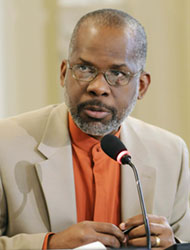- English
- Español
The OAS in Copenhagen: "Climate change a grave threat to development"
 Cletus Springer, Director of the OAS Department of Sustainable Development, attended the 15th United Nations Climate Change Conference (COP 15) in Copenhagen from December 7 to 18, 2009. In a recent interview, Mr. Springer elaborated on the work of the OAS in helping countries cope with climate change and its related challenges to the region.
Cletus Springer, Director of the OAS Department of Sustainable Development, attended the 15th United Nations Climate Change Conference (COP 15) in Copenhagen from December 7 to 18, 2009. In a recent interview, Mr. Springer elaborated on the work of the OAS in helping countries cope with climate change and its related challenges to the region.
What is the OAS position on Climate Change?
The OAS believes climate change poses perhaps the gravest threat to development prospects of the Hemisphere, in particular to small, island developing States; countries with low-lying coastal, arid and semi-arid areas or areas vulnerable to floods, drought and desertification.
The OAS view is that any threat to the development prospects of the region and to the livelihood of its people constitutes a threat to hemispheric security. Therefore, we remain committed to the United Nations Framework Convention on Climate Change (UNFCCC) and its objective of achieving stabilisation of greenhouse gas concentrations in the atmosphere.
How is the OAS helping its Member States cope with climate change?
In accordance with the various mandates and agreements reached over the years, including the decisions taken at the Fifth Summit of the Americas held in Trinidad and Tobago in April 2009, the OAS, through its Department of Sustainable Development, has been working along several paths to assist its member states to cope with climate change.
For example, OAS actions in mitigation are focused on assisting Member States to pursue sustainable energy pathways including the adoption of diversified energy policies and programs that emphasize renewable energy technologies (RETs).
The OAS’ efforts in the area of climate change adaptation aim at improving regional cooperation and strengthening national technical and institutional capacity for disaster reduction, prevention, preparedness and response, rehabilitation, resilience, risk reduction, impact mitigation, and evaluation. For some time, we have been working in Central America in monitoring, surveillance, communications, and early warning systems, and we have stimulated the sharing of information and research on disasters through resources such as the Inter-American Committee on Natural Hazard Reduction (IACHNDR) and its Inter-American Network on Disaster Mitigation (INDM).
How did the OAS contribute to the Copenhagen Conference?
The OAS’contributions to the Copenhagen Summit have been largely indirect. At a policy level, discussions on climate change—in the context of environmental sustainability—at the Fifth Summit of the Americas in Trinidad and Tobago produced a strong statement of commitment by the Heads of State and Government of the Hemisphere to address climate change in its various dimensions. These discussions helped to forge a common understanding of the implications and complications of climate change among OAS Member States who are part of the Group of 77 and China which is a major negotiating block in the UNFCCC negotiations.
At a programmatic level, the OAS helped to strengthen the capacity of Caribbean countries to participate effectively in the Summit by providing technical support for the Caribbean Community (CARICOM) Strategy on Climate Change and Sustainable Development. Additionally the OAS provided technical assistance with the planning and convening of the First Global Conference on Indigenous Peoples and Climate Change held in Anchorage, Alaska, in April 2009 which produced the Alaska Declaration, which informed the negotiating positions of Indigenous Peoples in COP 15.
The Summit called on rich nations to take specific measures to reduce greenhouse gas emissions levels to mitigate climate change. What can the small, developing countries of the Western Hemisphere do to help bigger countries in this endeavor?
There is not a great deal that the small developing countries can do to assist the bigger countries to reduce their greenhouse gas emissions. On the other hand, the bigger countries can help the OAS support the efforts of the smaller countries at building their resilience to climate change, such as: strengthening domestic planning and zoning measures and building codes, as appropriate, in order to reduce risks, mitigate impact and enhance the resilience of future residential, commercial and industrial developments; promote education and training with the aim of increasing public awareness of natural disaster preparedness and of national plans for prevention, mitigation and post-disaster recovery. Additionally, the bigger countries can utilize the various networks within the OAS to facilitate the transfer of adaptation technologies to the more vulnerable countries.
At the hemispheric level, are there any specific commitments States have agreed on to help reduce climate change?
Two specific commitments come readily to my mind. One is the expressed intention of the United States to establish an Energy and Climate Change Partnership for the Americas as a vehicle for information sharing and joint action in energy management and its contribution to climate change mitigation.
The other commitment is the U.S.-Brazil Bilateral Agreement on Bio-fuels which aims at identifying the potential of bio-fuels for diversifying the energy matrix of the hemisphere as well as improving economic sustainability, competitiveness and socio-economic conditions throughout the region.
December 31st, 2009


